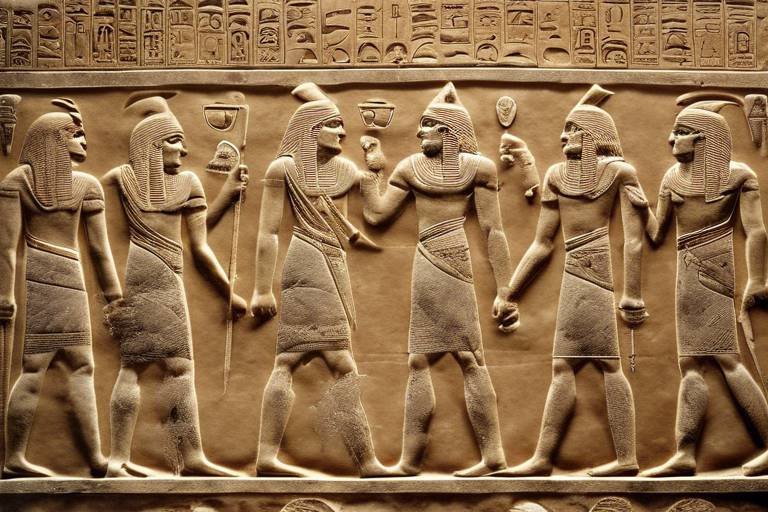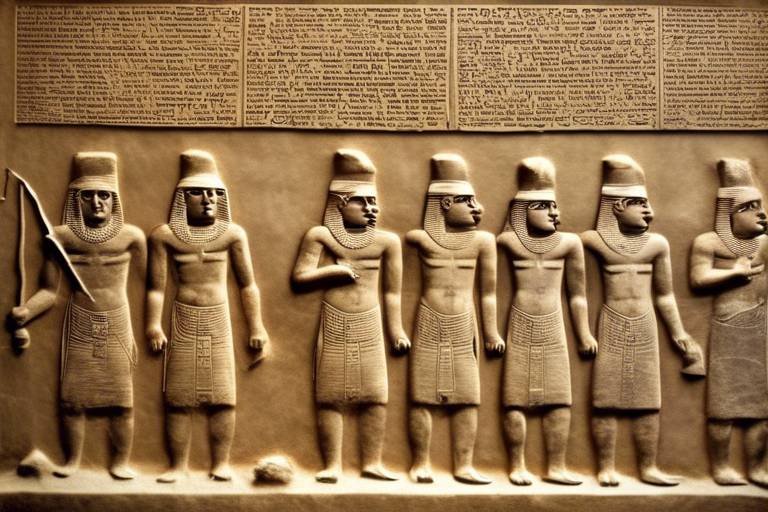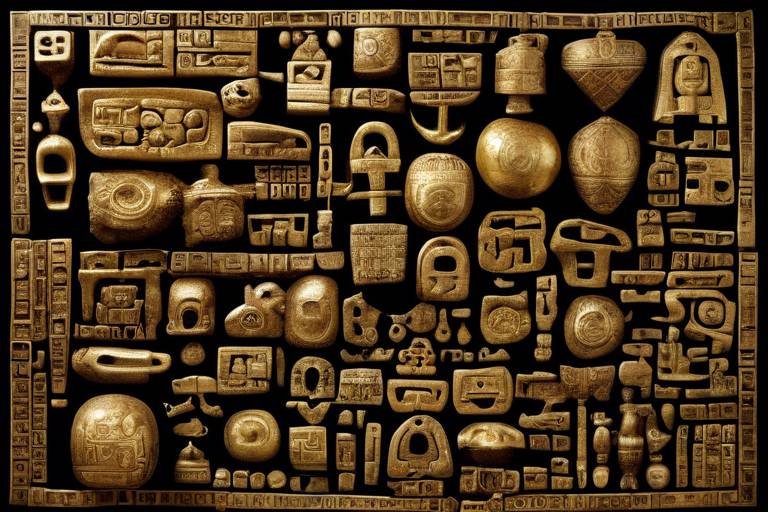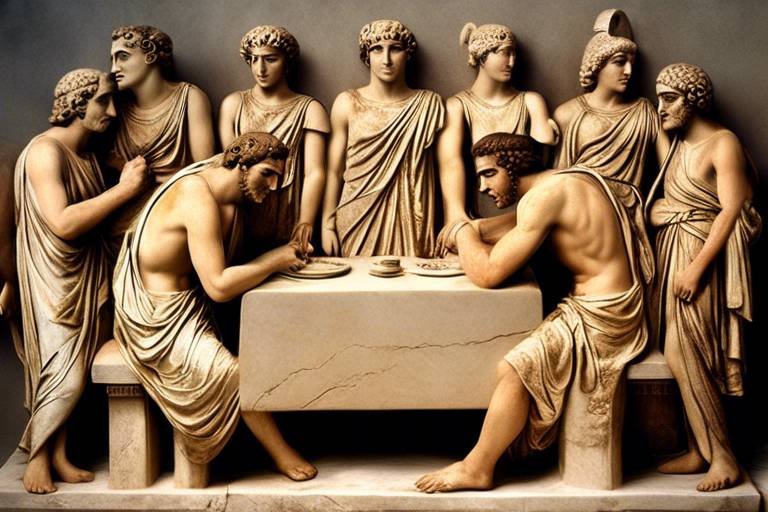The Cultural Richness of the Minoan Civilization
When delving into the cultural richness of the ancient Minoan civilization, one cannot help but marvel at the multifaceted aspects that defined this enigmatic society. From their intricate artwork to their grand palace complexes, the Minoans left behind a legacy that continues to captivate historians and archaeologists alike. Let's embark on a journey through time to explore the art, architecture, religion, trade, social structure, and daily life of one of the most advanced civilizations of the Bronze Age.
Art and Symbolism played a pivotal role in Minoan society, with their exquisite frescoes, pottery, and sculptures showcasing a unique artistic style. The intricate designs and vibrant colors not only reflected their aesthetic sensibilities but also held profound symbolic meanings, offering insights into the spiritual and cultural beliefs of the Minoans.
Palace Complexes like Knossos, Phaistos, and Malia stand as testaments to the architectural prowess of the Minoans. These grand structures served as both administrative centers and religious hubs, featuring intricate layouts, advanced plumbing systems, and intricate frescoes that depicted scenes from daily life and mythological narratives.
Religious Practices were an integral part of Minoan life, with a pantheon of deities worshipped in sacred sites across the island of Crete. The Minoans held elaborate rituals and ceremonies, often conducted in caves and peak sanctuaries, underscoring the spiritual significance of the natural landscape in their belief system.
Maritime Trade was a cornerstone of the Minoan economy, with their advanced seafaring skills enabling them to establish extensive trade networks across the Mediterranean. The abundance of luxury goods found in Minoan palaces attests to their economic prosperity and the thriving exchange of commodities with neighboring civilizations.
Social Structure in Minoan society was characterized by a complex hierarchy that encompassed ruling elites, priests, artisans, farmers, and slaves. The division of labor and social roles within the community shed light on the intricate web of relationships that defined Minoan society.
Gender Roles in the Minoan civilization defied traditional norms of the ancient world, with women holding prominent positions as priestesses, artists, and possibly even rulers. The depiction of powerful female figures in Minoan art challenges conventional notions of gender roles and highlights the unique social dynamics of this ancient society.
The enigmatic Writing System of the Minoans, known as Linear A, continues to baffle scholars to this day. The undeciphered script and symbols present a tantalizing mystery, prompting ongoing efforts to decipher the linguistic code and unlock the secrets of Minoan writing.
As we reflect on the Legacy and Decline of the Minoan civilization, we are reminded of the enduring impact they had on subsequent cultures. The sudden collapse of Minoan society around 1450 BCE, attributed to natural disasters or external invasions, marked the end of an era but left behind a cultural legacy that reverberates through Greek mythology and art.

Art and Symbolism
The art of the Minoan civilization is a mesmerizing tapestry of vibrant colors, intricate patterns, and symbolic representations that offer a window into their rich cultural tapestry. From the exquisite frescoes adorning the walls of palaces and villas to the delicate pottery decorated with scenes of daily life and mythical creatures, Minoan art reflects a society deeply connected to nature and spirituality.
One of the most iconic symbols in Minoan art is the bull, often depicted in various contexts such as bull-leaping scenes or as a sacred animal in religious ceremonies. The bull symbolizes strength, fertility, and power, embodying the essence of Minoan beliefs and rituals. Additionally, motifs like dolphins, octopuses, and lilies are recurrent in their artwork, hinting at their close relationship with the sea and the natural world.
The intricate designs and motifs found in Minoan art are not merely decorative but carry profound symbolic meanings. The use of spirals, meanders, and geometric patterns symbolizes concepts like eternity, infinity, and the interconnectedness of all things. These symbols transcend mere aesthetic beauty, offering glimpses into the spiritual and philosophical beliefs of the Minoans.
Moreover, the Minoans' artistic creations serve as a testament to their advanced craftsmanship and sophisticated artistic sensibilities. The meticulous attention to detail, the harmonious blending of colors, and the innovative techniques employed in their artwork showcase a civilization at the pinnacle of artistic achievement during the Bronze Age.

Palace Complexes
Palace complexes were integral to the Minoan civilization, serving as multifunctional centers that combined administrative, residential, and religious purposes. Among the most notable palace complexes were Knossos, Phaistos, and Malia, each showcasing the architectural sophistication and organizational complexity of Minoan society. These sprawling structures, often referred to as "palaces" due to their grandeur and significance, featured intricate layouts with interconnected courtyards, storerooms, workshops, and residential quarters.
At the heart of these palace complexes lay the central court, a focal point for social gatherings, religious ceremonies, and administrative activities. The Minoans demonstrated their engineering prowess through advanced plumbing systems, multi-story buildings, and elaborate decorations such as frescoes depicting vibrant scenes of daily life, nature, and religious rituals.
The layout of the palace complexes reflected the hierarchical structure of Minoan society, with designated areas for the ruling elite, priests, artisans, and laborers. The presence of specialized workshops and storage facilities indicated a thriving economy supported by craft production, agricultural activities, and trade networks that extended across the Aegean Sea.
Furthermore, the religious significance of the palace complexes was evident in the presence of sacred spaces, shrines, and ritual areas dedicated to various deities worshipped by the Minoans. The architectural design incorporated elements of nature, such as light wells, staircases, and open-air courtyards, symbolizing the interconnectedness of the spiritual and earthly realms.

Religious Practices
Religious practices were deeply ingrained in the fabric of Minoan society, shaping their beliefs, rituals, and interactions with the divine. The Minoans worshipped a pantheon of deities, with a particular emphasis on nature, fertility, and the underworld. Sacred sites, such as caves and peak sanctuaries, played a crucial role in religious ceremonies, serving as portals to the spiritual realm. The Minoans engaged in elaborate ceremonies, including processions, libations, and possibly even bull-leaping rituals, as depicted in their vibrant frescoes.
Their religious beliefs were intertwined with everyday life, influencing agricultural practices, trade expeditions, and communal gatherings. The presence of priestesses suggests a prominent role for women in religious affairs, with some scholars speculating that certain female figures held significant power within the religious hierarchy. The Minoans' reverence for the natural world is evident in their art and symbolism, with motifs of animals, plants, and marine life recurring in religious iconography.

Maritime Trade
Maritime trade was a cornerstone of the Minoan civilization, propelling their economy and connecting them with distant lands through the vast expanse of the Aegean Sea. The Minoans, renowned for their seafaring prowess, established a network of trade routes that stretched from Crete to Cyprus, Egypt, the Levant, and beyond. Their ships, equipped with advanced navigational techniques for the time, facilitated the exchange of goods such as olive oil, wine, pottery, precious metals, and luxury items like ivory and exotic spices.
The strategic location of Crete at the crossroads of major trade routes enabled the Minoans to become dominant maritime traders in the Bronze Age, fostering economic prosperity and cultural exchange with neighboring civilizations. The bustling ports of Knossos and other coastal settlements served as hubs for the transshipment of goods, where merchants from diverse regions converged to barter and negotiate trade agreements.
One of the most iconic symbols of Minoan maritime trade is the depiction of ships on frescoes and pottery, showcasing the importance of seafaring activities in their society. These artistic representations not only highlight the technical skill of Minoan shipbuilders but also emphasize the cultural significance of maritime commerce in shaping their identity and fostering connections with distant lands.
Moreover, the Minoans' maritime trade networks played a crucial role in the diffusion of ideas, technologies, and artistic influences across the Mediterranean, contributing to the cultural richness and cosmopolitan nature of their civilization. The exchange of goods and cultural artifacts not only fueled economic growth but also fostered diplomatic relations and mutual understanding among different societies.
In conclusion, maritime trade was not just a commercial activity for the Minoans but a fundamental aspect of their identity and legacy. Their mastery of seafaring, coupled with their entrepreneurial spirit and willingness to engage with diverse cultures, solidified their position as key players in the ancient Mediterranean trade network, leaving a lasting impact on the history of commerce and cultural exchange.

Social Structure
Within the intricate tapestry of Minoan society, the social structure played a pivotal role in shaping the dynamics of daily life and governance. At the pinnacle stood the ruling elite, comprising the powerful monarchs and aristocrats who wielded authority over the land and resources. These elite figures oversaw the administration of the palace complexes, directing the economic activities and religious ceremonies that defined Minoan culture.
Beneath the ruling class, a complex hierarchy of priests, priestesses, and religious functionaries carried out the sacred rituals and ceremonies essential to the spiritual well-being of the community. The religious practices of the Minoans permeated every aspect of society, from agricultural fertility rites to elaborate ceremonies honoring the gods and goddesses of the pantheon.
Artisans and craftsmen formed another crucial segment of Minoan society, producing exquisite pottery, intricate jewelry, and elaborate frescoes that adorned the palaces and villas of the elite. These skilled workers contributed to the flourishing artistic culture of the Minoans, showcasing their craftsmanship and creativity in every piece they crafted.
Furthermore, farmers and laborers toiled the fertile lands of Crete, cultivating crops and tending to livestock that sustained the population and fueled the economic prosperity of the civilization. Their labor formed the backbone of Minoan society, ensuring a steady supply of food and resources essential for the functioning of the city-states.
Slaves, although a controversial and often overlooked aspect of Minoan society, also played a significant role in supporting the economy and infrastructure through their forced labor. These individuals, often captured in warfare or through other means, carried out menial tasks and manual labor essential for the functioning of the palace complexes and agricultural estates.

Gender Roles
Gender roles in the Minoan civilization were remarkably different from the norms of many ancient societies. Women held significant positions of power and influence, challenging traditional patriarchal structures. Priestesses played a crucial role in religious ceremonies, symbolizing the importance of women in spiritual practices. Some scholars even suggest the existence of queen figures, indicating a potential matriarchal society where women held authority and respect.
On the other hand, men in Minoan society were also actively involved in various aspects of life, including trade, craftsmanship, and administration. However, the prominence of powerful women in leadership roles distinguished the Minoans from other contemporary civilizations. This unique balance of gender roles contributed to the cultural richness and diversity of the Minoan society, offering a fascinating glimpse into an ancient world where gender equality was more pronounced.

Writing System
The Minoan civilization is shrouded in mystery, with one of the most enigmatic aspects being their writing system known as Linear A. This ancient script, consisting of undeciphered symbols, has puzzled scholars for centuries, leaving behind a linguistic puzzle waiting to be solved. Despite numerous efforts, the meaning and purpose of Linear A remain elusive, adding to the allure of the Minoan culture.
Imagine trying to decode a message from the distant past, written in a script that holds the key to unlocking the secrets of a civilization lost to time. Linear A presents a tantalizing challenge, inviting linguists and archaeologists to unravel its intricate symbols and potentially reveal the thoughts and beliefs of the Minoan people.
While Linear A remains a mystery, its existence hints at a sophisticated society that valued communication and record-keeping. The intricate nature of the script suggests a structured system of writing, possibly used for administrative purposes, religious texts, or even personal correspondence among the Minoans.
Efforts to decipher Linear A have been ongoing, with researchers studying the script in conjunction with other Minoan artifacts and inscriptions. By comparing the symbols to known languages and scripts of the ancient world, scholars hope to one day crack the code of Linear A and shed light on the language and culture of the Minoan civilization.

Legacy and Decline
Reflecting on the enduring legacy of the Minoan civilization, one cannot overlook the abrupt decline that befell this advanced society around 1450 BCE. The reasons behind this decline remain a subject of debate among historians and archaeologists. Some theories suggest that natural disasters, such as earthquakes or volcanic eruptions, may have played a role in the downfall of the Minoans. Others propose that invasions by foreign powers could have been a contributing factor.
Despite the mysterious circumstances surrounding their decline, the influence of the Minoan culture persisted in the ancient world. The intricate artwork, architectural achievements, and religious practices of the Minoans left a lasting impact on subsequent civilizations, most notably in Greek mythology and art. The myth of the Minotaur and the labyrinth at Knossos, for instance, are believed to have roots in Minoan traditions.
As the Minoan civilization faded into obscurity, its memory lived on in the collective imagination of later societies. The cultural achievements of the Minoans, though overshadowed by other ancient civilizations, continue to fascinate and inspire scholars and enthusiasts alike. The legacy of the Minoans serves as a reminder of the rich tapestry of human history and the enduring allure of the mysteries of the past.
Frequently Asked Questions
- 1. What is the significance of Minoan art?
Minoan art is highly significant as it provides a window into the cultural, religious, and social aspects of the ancient Minoan civilization. The intricate artwork, frescoes, and pottery not only showcase their artistic prowess but also reveal symbolic meanings and themes that were important to the Minoans.
- 2. How did the Minoans engage in maritime trade?
The Minoans were skilled seafarers who established extensive maritime trade networks in the ancient Mediterranean. They utilized their advanced ships to trade goods such as pottery, olive oil, and luxury items with other civilizations, contributing to their economic prosperity and cultural exchange.
- 3. What is known about the Minoan writing system?
The Minoan writing system, known as Linear A, remains largely undeciphered, posing a mystery to scholars. The symbols and script used in Linear A have yet to be fully understood, although ongoing efforts are being made to unlock the linguistic secrets of this ancient writing system.
- 4. What led to the decline of the Minoan civilization?
The decline of the Minoan civilization around 1450 BCE is believed to have been caused by a combination of factors, including natural disasters like volcanic eruptions and earthquakes, as well as possible invasions by outside forces. This abrupt decline marked the end of the Minoan dominance in the region.



















